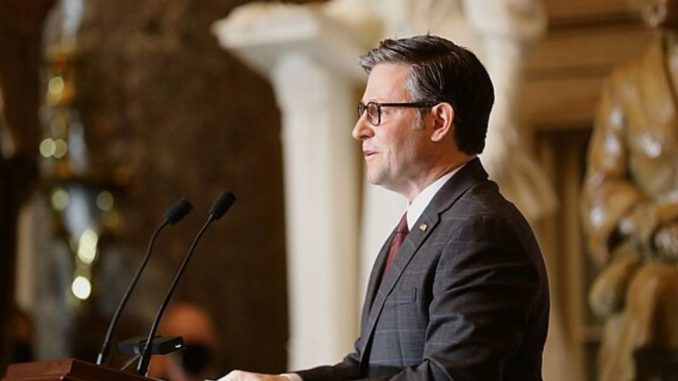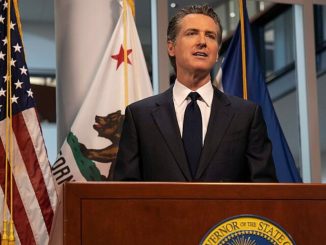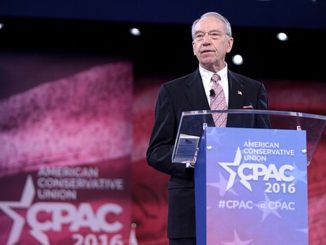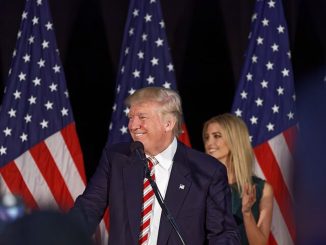
Three Key Takeaways:
- Donald Trump has pressured Speaker Mike Johnson to act swiftly on extending the 2017 tax cuts, emphasizing the urgency of delivering economic relief immediately, without delays or compromises.
- Trump’s 2017 tax policies were instrumental in the U.S. economy’s resilience, particularly during the COVID-19 recovery, and he wants the full benefits of tax cuts to be realized without any delay, unlike the Reagan administration’s slower approach.
- Johnson faces a critical test in rallying support for a fast tax cut extension, and Trump’s directive highlights the importance of immediate action to secure long-term economic growth and bolster Republican control.
Donald Trump won’t tolerate any delays when it comes to tax cuts.
Speaker Mike Johnson has his marching orders.
And Donald Trump just handed Mike Johnson this ultimatum about tax cuts that will make Democrats panic.
Trump demands fast action on tax cut extension
President Donald Trump has made it clear to House Speaker Mike Johnson (R-LA) that extending the 2017 tax cuts must be an immediate priority.
Time is of the essence, and the message from Trump Tower couldn’t be more direct – get it done now.
Renowned economist Amity Shlaes recently revealed that Republicans are nearing a breakthrough on the tax cut legislation.
“Republicans tell us they are close to finding the votes to pass a tax measure that extends the expiring 2017 tax cuts,” Shlaes wrote.
The deal on the table would extend Trump’s game-changing 2017 tax cuts, add new breaks for products made in America, and adjust the carried interest provision that hedge fund managers have exploited for years.
But Trump isn’t interested in half-measures or dragging the process out over months of debate. His directive is simple – deliver the tax cuts fast.
“That’s the thing about tax cuts. They work better when they come sooner,” Shlaes pointed out, highlighting the lesson learned from decades of American tax policy.
The 2017 tax cuts were the foundation of America’s economic resilience
Trump’s insistence on speed isn’t just political theater – it’s based on the undeniable success of his first-term tax policies.
The 2017 Tax Cuts and Jobs Act slashed the corporate rate and reduced the top marginal rate for individuals. The results were spectacular, creating an economy resilient enough to bounce back from unprecedented challenges.
When COVID-19 struck in 2020, causing nearly a 30 percent drop in GDP and unemployment rates approaching 15 percent, America’s economic foundation remained solid. The recovery was nothing short of remarkable.
“When Americans stepped out into the sunlight after their COVID hibernation, jobs were there to greet them,” Shlaes wrote. “Part of that vigorous activity came from the extraordinary federal spending on relief during the COVID period. But a good share of the new energy stemmed from the favorable tax situation.”
This stands in stark contrast to the painfully slow recovery following the 2008 financial crisis under Obama-Biden policies, and far outpaced the sluggish European economies’ post-COVID performance.
The 2017 tax law earned its historical nickname: architect of “The Great Recession That Wasn’t.”
Reagan’s tax cut delays created unnecessary economic pain
Trump’s pressure on Johnson isn’t without historical precedent. The Reagan administration’s tax cutting efforts in the 1980s illustrate exactly what not to do – delay implementation.
Reagan’s landmark Economic Recovery Tax Act reduced the top marginal rate from 70 percent to 50 percent, but the benefits were staged over several years instead of implemented immediately.
The consequences were severe.
“Delaying the tax cuts certainly contributed to the resumption of economic recession in 1981–1982,” concluded Lawrence Lindsey, who served on Reagan’s Council of Economic Advisers.
By August 1982, even after the first staged tax cut took effect, the prime rate still stood at a crippling 14 percent. Small businesses and startups suffered unnecessarily during the waiting period.
As the 1982 Midterms approached, unemployment crossed the 10 percent threshold, reaching levels not seen since the Great Depression. Republicans paid the price, losing seats in both houses of Congress.
Trump has studied this history and is determined not to repeat it. He wants the full economic benefit of tax cuts to be felt immediately, not delayed until after a critical election.
Johnson faces a critical test of leadership
Speaker Johnson now faces the most crucial legislative test of his leadership. Can he deliver the votes necessary to pass a clean tax cut bill immediately, or will he allow Democrats and moderate Republicans to water down and delay the legislation?
Trump’s ultimatum gives Johnson little room for extended negotiations. The President wants action, and he wants it now.
Unlike Reagan, who spent considerable time building coalitions with Democrats, Trump’s strategy relies on rapid action with the slim Republican House majority. As Shlaes notes, “This is the price of Trump tribalism.”
Johnson’s ability to rally his caucus behind a strong tax cut bill will determine whether Americans experience immediate economic benefits or must endure unnecessary financial pain while waiting for relief.
If Johnson succeeds, the economic gains could solidify Republican control of government for years to come. If he fails, voters may wonder why they handed Republicans control of the House in the first place.



